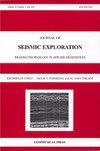Estimating seismic dispersion from prestack data using frequency-dependent AVO analysis
IF 0.4
4区 地球科学
Q4 GEOCHEMISTRY & GEOPHYSICS
引用次数: 32
Abstract
Recent laboratory measurement studies have suggested a growing consensus that fluid saturated rocks can have frequency-dependent properties within the seismic bandwidth. It is appealing to try to use these properties for the discrimination of fluid saturation from seismic data. In this paper, we develop a frequency-dependent AVO (FAVO) attribute to measure magnitude of dispersion from pre-stack data. The scheme essentially extends the Smith and Gidlow (1987)’s two-term AVO approximation to be frequency-dependent, and then linearize the frequency-dependent approximation with Taylor series expansion. The magnitude of dispersion can be estimated with least-square inversion. A high-resolution spectral decomposition method is of vital importance during the implementation of the FAVO attribute calculation. We discuss the resolution of three typical spectral decomposition techniques: the short term Fourier transform (STFT), continuous wavelet transform (CWT) and Wigner-Vill Distribution (WVD) based methods. The smoothed pseudo Wigner-Ville Distribution (SPWVD) method, which uses smooth windows in time and frequency domain to suppress cross-terms, provides higher resolution than that of STFT and CWT. We use SPWVD in the FAVO attribute to calculate the frequency-dependent spectral amplitudes from pre-stack data. We test our attribute on forward models with different time scales and crack densities to understand wave-scatter induced dispersion at the interface between an elastic shale and a dispersive sandstone. The FAVO attribute can determine the maximum magnitude of P-wave dispersion for dispersive partial gas saturation case; higher crack density gives rise to stronger magnitude of P-wave dispersion. Finally, the FAVO attribute was applied to real seismic data from the North Sea. The result suggests the potential of this method for detection of seismic dispersion due to fluid saturation.利用频率相关AVO分析从叠前数据估计地震频散
最近的实验室测量研究表明,流体饱和岩石在地震带宽内可能具有频率依赖性。尝试利用这些性质从地震资料中区分流体饱和度是有吸引力的。在本文中,我们开发了一个频率相关的AVO (FAVO)属性来测量叠前数据的色散大小。该方案本质上是将Smith和Gidlow(1987)的两项AVO近似扩展为频率相关的,然后用泰勒级数展开对频率相关的近似进行线性化。用最小二乘反演可以估计色散的大小。在实现FAVO属性计算过程中,高分辨率的光谱分解方法至关重要。讨论了三种典型的光谱分解方法:短时傅里叶变换(STFT)、连续小波变换(CWT)和基于Wigner-Vill分布(WVD)的方法。平滑伪Wigner-Ville分布(SPWVD)方法利用时域和频域平滑窗口抑制交叉项,具有比STFT和CWT更高的分辨率。我们在FAVO属性中使用SPWVD从叠前数据中计算频率相关的频谱幅度。我们在不同时间尺度和裂缝密度的正演模型上测试了我们的属性,以了解弹性页岩和色散砂岩之间界面的波散射诱导色散。在色散部分气饱和情况下,FAVO属性可以确定p波色散的最大震级;裂纹密度越大,纵波频散强度越大。最后,将FAVO属性应用于北海实际地震资料。结果表明,该方法在检测流体饱和度引起的地震频散方面具有潜力。
本文章由计算机程序翻译,如有差异,请以英文原文为准。
求助全文
约1分钟内获得全文
求助全文
来源期刊

Journal of Seismic Exploration
地学-地球化学与地球物理
CiteScore
0.70
自引率
0.00%
发文量
0
审稿时长
4.5 months
期刊介绍:
The Journal of Seismic Exploration is an international medium for the publication of research in seismic modeling, processing, inversion, interpretation, field techniques, borehole techniques, tomography, instrumentation and software.
 求助内容:
求助内容: 应助结果提醒方式:
应助结果提醒方式:


